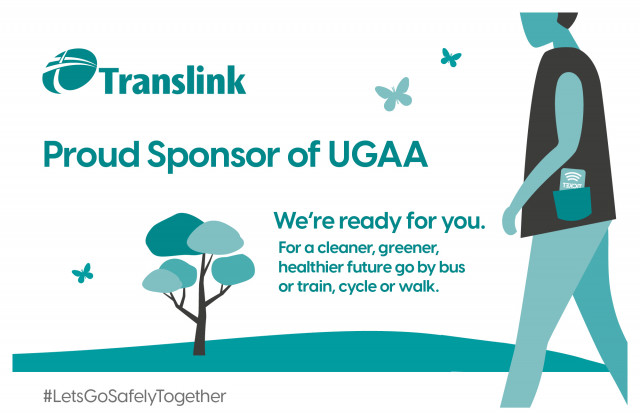Statistical Analysis of Cavan v Armagh
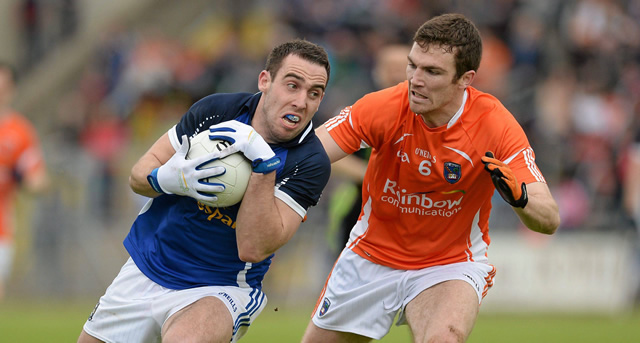
Throughout the 2013 Ulster Senior Championship, Ulster GAA will be compiling a report of the key statistics from each match. The reports will look at a range of factors contributing to game play, including possession breakdown, kick out success, possession to scores ratios and turnover stats.
The purpose of this project is to identify the key differences between team performance, and possibly help pin point where the key differences existed. Ultimately, it is hoped to identify the key area each team needs to address ahead of their next championship outing in 2013.
Ball in Play
The FRC made proposals earlier this year to introduce a public time clock and also to lengthen senior county matches to 40 minutes per half. Part of the rationale for both of these proposals was the issue of active game time in a 70 minute match. An in depth study had highlighted that active game time in 70 minute games was generally less than 35 minutes, when allowing for all stoppages. The statistics from the Cavan v Armagh further highlight the issue of active game time. Figure 1 below demonstrates that the ball was ‘in-play’ for 32 minutes and 54 seconds, which equated to only 44% of the game time. The graph also highlights that the ball was ‘dead’ for 41 minutes 49 seconds of the game time.
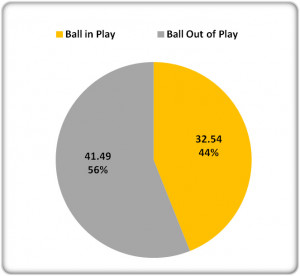
Figure 1: Active Game Time
Possession
Possession is a common statistic measured when observing game play. There is little or no relationship between possession and success, however, it is interesting to observe differing tactical approaches and how this may correlate with possession and outcome. Figure 2 below shows the first half possession balance.
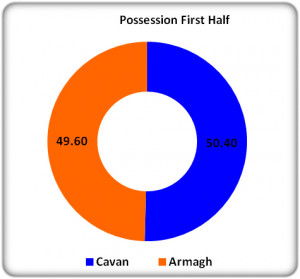
Figure 2: 1st Half Possession
Despite the equally balanced possession, Cavan were leading by 1-06 (9) to 0-04 at half time. The 5 point lead may have contributed to the possession balance in the 2nd half being in Armagh’s favour, as shown in figure 3.
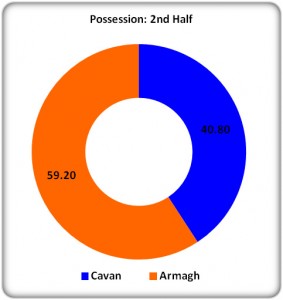
Figure 3: 2nd Half Possession
Overall possession balance again reinforces the theory that greater possession share does not necessarily translate to overall success.
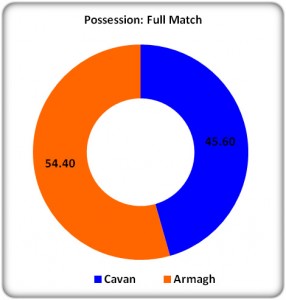
Figure 4: Full Match Possession
Kick Outs
There is a long standing belief in Gaelic football that primary possession, won from kick outs, is essential to a team’s chance of success. That said, as the game evolves and the tactical approaches vary from team to team, it has been suggested that primary possession is no longer vital to a team’s prospects of winning the match. Figure 5 reveals that Armagh were dominant in this area during Sunday’s match, and therefore offers further support to the argument that primary possession success is not important in relation to match outcome.
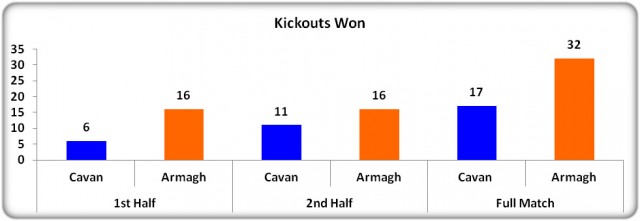
Figure 5: Kick Out Possession
Possession to Scores Ratios
With Armagh seemingly superior in possession measure displayed above it is important to identify why this superiority was not converted to a successful outcome. An effective way to measure how efficient a team is with possession is to measure:
1) How many possessions are converted to attacks (pass the opposition 45m line);
2) How many attacks are converted to a shot (goal or point, from set play or open play);
3) How many shots are converted to scores (goals or points).
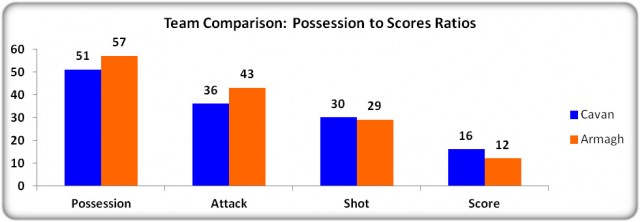
Figure 6: Possession to Scores Ratios
As expected, Armagh has a superior number of possessions, and were also able to convert a similar percentage of these possessions to attacks: Cavan – 71%, Armagh 75%. However, it appears Armagh were less effective at converting their possession to shots: Cavan – 59% of all possessions, Armagh – 51% of all possessions. Ultimately, Cavan were able to convert 31% of all possessions to scores, while in contrast Armagh could only convert 21% of all possessions to scores.
Turnovers
As figure 6 depicts, Armagh were less efficient at converting attacks to shots, which would suggest that they have lost possession before creating the shooting opportunity. A simple analysis of the turnover statistics from the match highlights where the main differences lay between both teams.
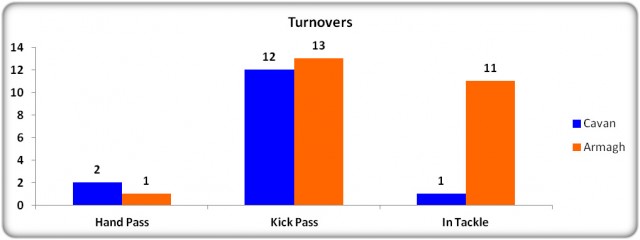
Figure 7: Turnover Statistics
It is clearly evident from figure 7 that the volume of turnovers has cost Armagh, in terms of giving up possession before creating the shooting chance. And even more evident is the fact that Armagh lost 11 possessions in the tackle, when compared to only 1 such turnover by Cavan.
Summary
In summary, despite the evidence that Armagh were able to secure primary possession much better than Cavan, and in turn a greater possession share throughout the entire match, they were much less efficient with the possession. Both teams were able to convert a similar volume of possessions into attacks, but Cavan were much more effective and manufacturing the scoring opportunity and subsequently and generating scores.
Cavan
While the result of the match is the clear positive for Cavan, they must take note of the possession statistics, in particular the volume of kick outs won by the opposition. Going forward, if they meet a team more effective at converting possession to scoring chances they will likely suffer defeat. On the other hand, they should be satisfied with excellent conversion rates between possessions and scores.
Armagh
Despite the result, Armagh must look at the major positive from this match, and that is the volume of primary possession secured from kick outs. Training focus ahead of the first round of the All- Ireland qualifier series must focus on utilisation of this possession and creation of scoring chances.
For further information please contact Kevin McGuigan on kevin.mcguigan.ulster@gaa.ie



